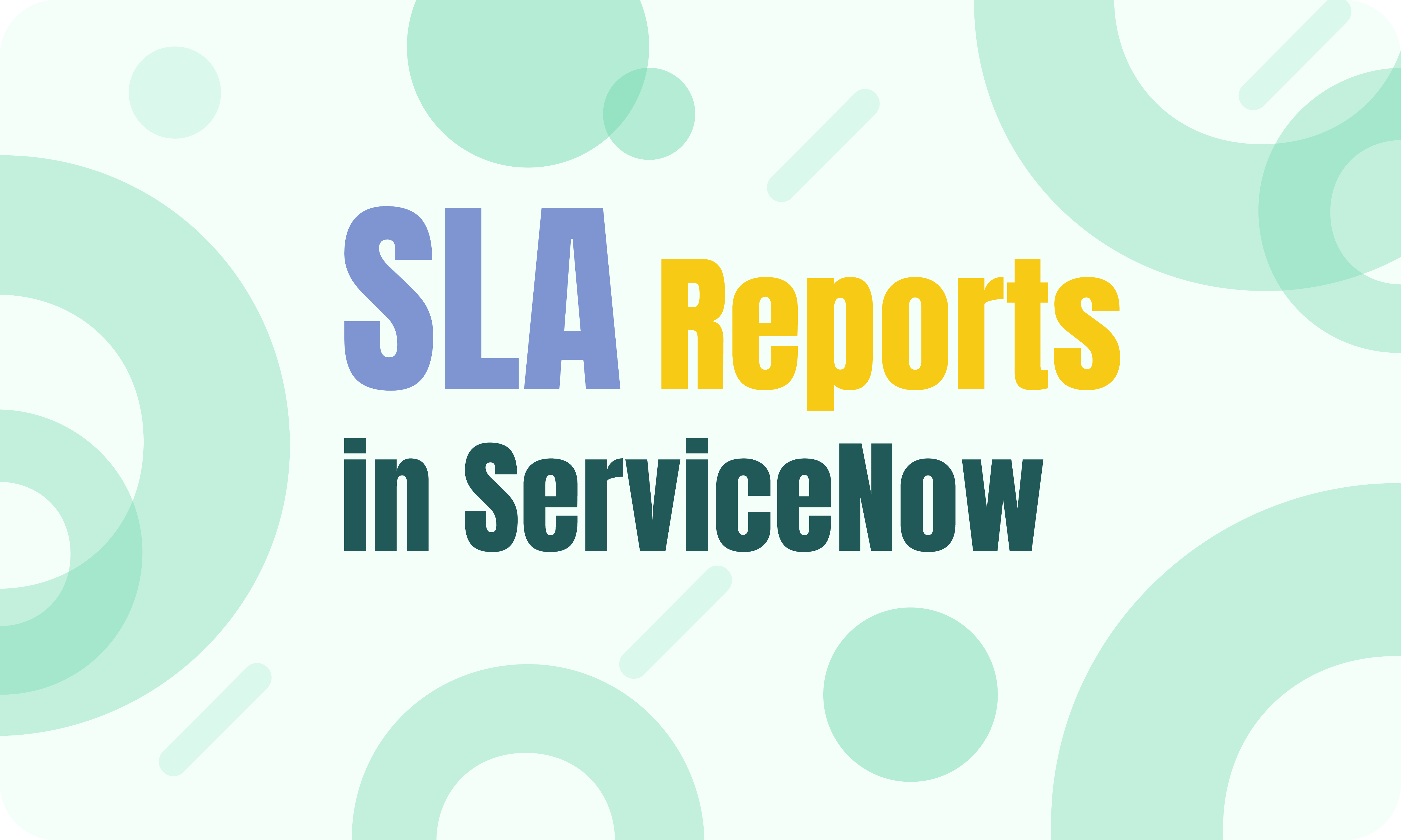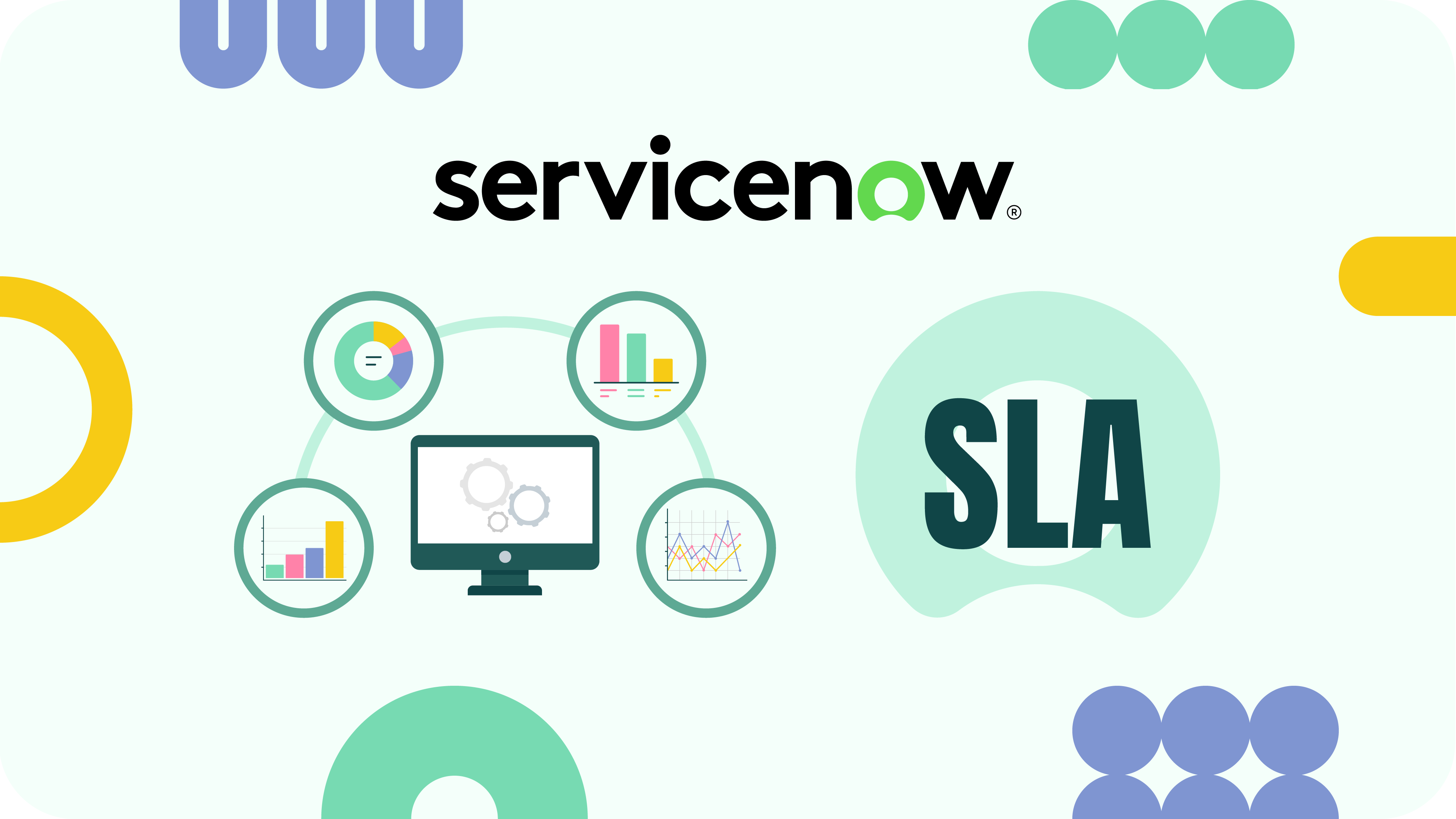SLA report is a must for companies that want to reveal areas for improvement, track business performance, and measure the level of satisfaction among customers. They are used to understanding the complex system of delivering great service. SLA monitoring and reporting help service providers and customers collaborate more effectively to ensure that services delivered meet agreed quality levels and lead to business success.
In this article, we will get insights about the difference between SLA reports, SLA reporting, and monitoring and show how to set up SLA in ServiceNow.
- What is an SLA Report
- Setting Up SLAs in ServiceNow
- Creating SLA Reports in ServiceNow
- SLA Monitoring and Service Level Reporting
- Conclusion

What is an SLA Report
Before answering the question of what is an SLA report in ServiceNow, first, let’s define and explore the meaning of SLA and its importance in customer-business relationships. Service Level Agreement (SLA) is an agreement about the level of service that customers expect to get from a provider, defining metrics that measure this service and explaining remedies or penalties if this service level isn’t achieved. They are fundamental for building trust between the IT team and the customer and understanding service expectations. Usually, they are made between companies and third suppliers but can also be between departments within a company. SLAs are a key element of outsourcing.
While the SLA report meaning is an on-demand report where you can analyze and evaluate the acceptable SLA level of a single resource or website over a specified period; service level reporting is a customized collection of metrics of technical indicators of a certain subset of systems.
Implementing SLAs can be beneficial for your IT team in several ways:
- For customers, SLA reports help determine whether the service provider continues to meet their expectations, show actual availability statistics, and help identify performance issues. Furthermore, documenting when SLAs are unmet allows us to get proper refunds or credits.
- For service providers, service level reporting shows customers that they are constantly monitoring and controlling site uptime, provides documentation, proves actual uptime, and helps to resolve SLA disputes and avoid backlogs. It also helps to quickly identify responsible parties when SLAs fall below a pre-defined threshold.
SLA Report Examples
Providing excellent customer service is a way to set the customer’s expectations. ServiceNow offers a range of SLA monitoring features that help organizations meet customer expectations and identify areas for improvement. These features include tailored workflows and escalations based on specific parameters, automatic alerts and warnings, and integration with other IT service management tools. Here are SLA examples:
- Customer SLA is an agreement between an organization and a third-party vendor providing a service. For example, an organization may hire a design or SMM agency to meet specific business needs.
- Internal SLA is an agreement between teams inside an organization. For example, the sales team may recruit the marketing teams to help generate leads or promotional offers.
- Multilevel SLA is an agreement between different parties (organization and a few vendors, more than two teams within a company) to provide services with different service plans. For example, the marketing and sales teams may ask the customer support team to improve customer satisfaction.
In a case study with ABC Corporation, they were able to improve service efficiency and customer satisfaction by utilizing ServiceNow’s automation and real-time reporting capabilities. This allowed them to accurately monitor SLA performance and identify potential delays in service delivery. By aligning their workforce with ServiceNow metrics, ABC Corporation optimized resource allocation and met SLA commitments, exceeding customer expectations. This service level agreement example shows that ServiceNow provides organizations with the tools they need to effectively monitor and manage SLAs, leading to improved service delivery and customer satisfaction.
Setting Up SLAs in ServiceNow

The SLA definition record defines the time, conditions, workflows, and other information needed to establish and advance SLAs for an activity. One or more SLA definitions can be created and used to create the SLA record that allows you to use the SLA system for your organization’s activities.
When creating an SLA definition, don’t use dot-walked fields that change frequently in any of the SLA conditions (start, stop, pause, and reset). The SLA engine has certain functions like SLA scheduling and SLA remediation that replicate the audit history of the task_sla to which it’s linked. However, the SLA engine considers only the final state of dot-walked fields during SLA Repair and SLA Timeline.
- Navigate to All > Service Level Management > SLA > SLA Definitions.
- Click New.
- Field in the required fields in SLA Definition form:
- Name to identify SLA definition.
- Type: choose an agreement type (SLA, OLA, Underpinning contract).
- Target: choose target (SLA, OLA, Underpinning contract). This feature is available just in new instances.
- Table: tracked records (e.g., incident, change request).
- Flow/Workflow: to run with the SLA.
- Enable logging: check box to activate debug logging just for the specific SLA definition.
- Vendor: associated vendor.
- Duration Type: choose duration calculation method (User specified duration, or a Relative Duration, such as Breach on Due Date or End of next business day).
- Schedule source: choose among specific options (No Schedule, SLA definition, Task field).
- Start/ Pause/ Stop or Reset Conditions: define conditions for pausing, stopping or resetting the SLA.
- Condition type: add field to determine when an SLA attaches, pauses, completes, or resets.
Image Source: ServiceNow Documentation
Creating SLA Reports in ServiceNow

Creating SLA reports in ServiceNow is easy and efficient. Follow this step-by-step guide, select the necessary metrics, and check the status or follow the link to watch How to create SLA Report.
Accessing the Reporting Module
- Log in: Open the ServiceNow platform and log in with your credentials.
- Navigate to Reports: On the homepage, find the “Reports” module on the left-hand side.
- Open Report Designer: In the submenu, select “Report Designer” to access the Report Builder tool.
- Choose Service Level Management: Under the Service Level Management category, select “Service Level Agreement (SLA)” to start building your report.
Selecting the Data Source
- Access the SLA Dashboard: Navigate to the SLA dashboard to begin customizing your report.
- Choose the Data Source: Select the appropriate table or data source, such as the SLA Task table, for your report.
- Set SLA Parameters: Choose the relevant fields and filters for your report, such as Priority, Status, or Assignee. You can also select specific SLA metrics like Business elapsed time, Actual elapsed time, or Pause duration.
- Customize Fields: Name the report, define key trends (e.g., by Created or Activated), and apply any necessary filters.
- Save or Discard Changes: Click “Save” to keep your changes or “Cancel” to clear the form.
Designing the Report
- Select Key Metrics: Choose SLA parameters that are crucial for your analysis, such as:
- Response Time: Measures how quickly a ticket is addressed.
- Resolution Time: Tracks the time taken to resolve an issue.
- Customer Satisfaction: Reflects the quality of service as rated by the customer.
- Customize Visuals: If the default metrics don’t meet your needs, customize widgets and visualization.
- Add Widgets: Use the Report Builder menu to add widgets. Drag and drop them into the report preview, and click “Save Report” at the bottom of the page.
- Edit or Delete Widgets: To modify, click “Edit” under the existing report, adjust settings, and save. To delete a widget, use the red minus button and save the changes.
- Select the Right Visuals: Choose from various visual types to represent your data effectively:
- Bar Graphs: Compare metrics across different periods or categories.
- Pie Charts: Show the distribution of SLA violations among teams or departments.
- Line Graphs: Ideal for tracking SLA compliance trends over time.
- Tables: Display detailed information about individual SLAs.
- Dashboards: Provide an overview using multiple charts and visuals.
- Scorecards: Highlight key SLA metrics at a glance.
- Configure Layout: Adjust the report layout, format, and sorting options to suit your needs. Test the report and modify it as necessary for clarity and effectiveness.
Setting Up Report Schedules
- Run the Report: Once your report is customized, click the “Run” button to generate it.
- Apply Advanced Filters: Use filters based on status, priority, or assignment group to focus on the most relevant data.
- Schedule Reports: For regular monitoring, set up a schedule to run the report daily, weekly, or monthly.
- Assign Recipients: Choose who will receive the report and ensure they have the necessary access.
- Set Alerts: Configure email alerts to notify stakeholders of any SLA violations.
- Export or Share Reports: If the report is satisfactory, export or share it with your team for further analysis.
- Automate Notifications: Implement automated SLA notifications and reminders to ensure timely responses to any potential issues.
SLA Monitoring and Service Level Reporting

SLA monitoring takes place after the contract is signed to meet the customer’s expectations. The process is carried out through various statistics, such as a systematic data collection process, data analysis, data tracking, and other factors that increase the value of the company. When the monitoring is done, start SLA reporting where you can see a dashboard with policies, time, and status, allowing you to identify problem areas. These two features allow us to meet the agreement and provide the best performance.
SLA monitoring, measuring and service level reporting includes evaluating the service provider’s performance against specific criteria and objectives described in the SLA. This brings some benefits to both the service provider and the customer. It provides an objective way to evaluate if the service level was achieved, can help to ensure the service quality to the customers, identify areas that need improvement, detect issues or potential problems early and correct them before they cause a problem, manage customer expectations by giving a clear understanding of the level of service they will get.
Analyzing and interpreting data in SLA reports in ServiceNow is crucial for identifying patterns and trends that can improve service delivery and highlight areas for improvement. In addition to these metrics, obtaining information on the reasons behind successful or unsuccessful service levels is important. This can be done by analyzing incident logs, change management data, and customer feedback to identify any systemic issues affecting SLA performance. Visual representations, such as tables and graphs, are also helpful in understanding the data, as they make it easier to identify trends, anomalies, and correlations that may not be apparent in raw numbers. Overall, a thorough analysis of the data in SLA reports in ServiceNow enables organizations to make informed decisions and take corrective actions when necessary.
Conclusion
Creating SLA reports in ServiceNow is an essential option for businesses willing to provide the top service level. They show the areas of improvement, allow to measure customer satisfaction, track overall performance, and help organizations boost their service management processes and provide better experiences to their customers. Furthermore, SLA monitoring offers real-time insights into the performance to ensure transparency and visibility to maintain service quality. Key metrics like response times, problem resolution rates, and customer satisfaction ratings are used to assess service standards and measure performance against predefined goals.
In this article, we have tried to uncover the secrets of accessing SLA reporting. Use ServiceNow’s powerful reporting features to enhance SLA report management and ensure high service standards of services.

